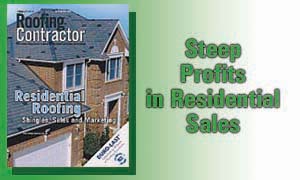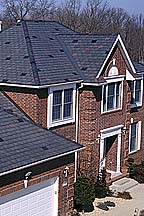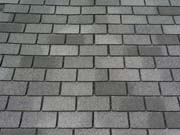Steep Profits in Residential Sales


By their very nature, residential roofing projects have many challenges that are hardly offset by the limited profit margins and small volumes. But there is a tremendous need for proper installation and the amount homeowners spend just on home improvement and repairs exceeds all of commercial construction ($214 billion vs. $131 billion; see Roofing Contractor — July 2003, pg. 35). Today’s consumers are more savvy about quality products, have done their research and are willing to pay for attractive, durable roofing systems. The roofing contractor that can address a variety of concerns and effectively communicate his solutions can expect a consumer that is receptive to premium materials.

Capturing the Market
“The roofing contractor does lead the way,” says Don Kennedy of Don Kennedy Roofing in Nashville. “He’s the one that lays in front of the customer what the options are. It’s our job to lead them in the right directions.”Kennedy, who has been performing residential roofing since 1978, takes advantage of a variety of sales tools to make his company’s presentations more effective. Training is a big component for his sales staff, from manufacturers’ representatives discussing new products to generic sales programs. His company recently completed a 32-module program that involved activities every day for six months to reinforce the mindset that a customer’s needs don’t instantly translate into dollar signs.
“We really find out what they want,” Kennedy says. “What’s their biggest concern? We like to be able to explain to them why is this better.”
Kennedy thinks one of his best selling tools are basic repairs; even those estimates are free. (Each commercial estimate comes in a notebook.) Often that repair work converts into negotiated contracts with no competition. In a captive setting, Kennedy’s teams go over concepts like ventilation, fungus resistance and aesthetics. The latter is a driving force where certain styles take off. He keeps tabs on the latest products and has on several occasions worked directly with a manufacturer installing a new shingle profile, which immediately becomes a sales tool. “We’ve done some where a big part of the neighborhood will go to that shingle just because somebody put it on their house,” he says.
A nearby hailstorm has created quite a bit of work, but Kennedy says they’re too infrequent to impact codes ... yet. His weather troubles began in the winter when it snowed or rained nearly every day in February and March, setting back his production schedule so far that in late July he was booking jobs for the end of November. While a summer backlog is typical, his residential, commercial, repair and roof cleaning crews are all jammed.
Still, Kennedy keeps the word out through bus benches, yard signs and morning television. He runs a small Yellow Pages ad but — since he carefully tracks all leads — he admits dreading those calls. Usually they’re angry homeowners looking for the cheapest price and those inquiries don’t necessarily go to the top of his 7-inch stack of estimates.

Top Line
Just like luxury SUVs are driving the car market, luxury homes are a leading trend in home sales. Sales for new U.S. homes costing $300,000 and more account for 20 percent of new homes, the second largest category in volume alone according to the Census Bureau and the U.S. Department of Housing and Urban Development. The category also has been showing steady numbers for a year and even tied for the largest category with homes in the $150,000 to $199,999 range for May and June of this year (24,000 and 26,000 units respectively). This stable stream of pricey homes being built presents many opportunities to sell premium roofing products and accessories.While professional roofing contractors are not on the radar for most moderately priced homes, their involvement increases with the price and complexity of premium roofing materials. Even the mid-range homes call for tile and metal, so selling opportunities aren’t just limited to reroofing jobs.
There was a time when most of the roofing and siding work performed by A.H. Davis & Son Inc. was for new homes. The Nashville company, founded in 1939, had to change gears around 1991 when the real estate market crashed. It started a commercial division that now accounts for half of the company’s revenues. The company now works for only a handful of homebuilders while maintaining healthy margins doing reroofing.
“When we were allowed to make the margins, we were interested [in new construction],” says Kirk Davis, grandson of the founder. “We find that people are choosing value much more so than price...I don’t know where the bad economy is.”
The company has weathered an erratic market by diversifying its business, capitalizing on institutional strengths and addressing the specific needs of an increasingly informed consumer. He takes homeowners through their options, covering such factors as ventilation, warranty, performance and appearance. It also helps that the man selling them a roof is a third generation roofing contractor.
“It means a lot to people,” says Davis. “We’ve closed a lot of deals because our competition isn’t as thorough in their proposals.”
The company is even known to lay shingles on the existing roof to help people with decisions. Aesthestics are the key reason Davis is selling a lot of laminated shingles, including replacements for slate roofs. Even when people come to him with a file of information, he doesn’t assume people understand their roof, especially when price becomes the driving factor. Davis is too busy to get hammered. “We have other places to be,” he says. “If a customer has done his or her homework thoroughly enough to go after price, they’re in the wrong place...If we’re the lowest, then somebody made a mistake.”
“The only time I do new construction is when they need it fast and right,” says Robert Maddox of Hahn Roofing in Spencer, Iowa. The company, founded in 1978, counts on residential projects for about 70 percent of revenues. He’s pragmatic with homeowners about their options and has been selling laminate look-alikes, as well as premium products like TAMKO’s Heritage XL. Past slate installations have taught him to be cautious about the source because Iowa’s brutal winters can crack slate that’s too porous. He also says there’s a lot of shoddy work being performed and his company’s reputation has helped out many people in distress. “You’d be surprised at how many of them actually have to get burned,” he laments. “We differentiate ourselves from others with quality and honesty.”
While most of the small municipalities in Iowa have yet to adopt the new International Building Code — many lack inspectors and there is no state license required for roofing contractors — he still installs ice and water shields where needed, tears off multiple layers of shingles, and actively promotes proper ventilation and installation to the customer. In an environment that he describes as a “free-for-all,” Maddox gets particularly frustrated when a hailstorm attracts storm chasers. Recent storms have created a pattern for repair schemes designed to exploit desperate homeowners.
When Mason City, 80 miles east of Spencer, was hit with hail in June 2002, Maddox estimates that 40 new companies sprouted up to fix the damaged roofs. Through a variety of methods, these “contractors” were able to use an existing company name — sometimes even the old phone number — giving them instant credibility. After the work was done, they disappeared until Rockwell got hit earlier this year. “And these guys went right back in there and attacked it,” Maddox says. “A lot of these guys are offering contracts where there is no price ... I don’t see how people can sign that, but they do.”
The irony is that homeowners are starting to wise up and if storm chasers had any interest in longevity, they might get repeat business instead of repeat complaints. It’s not always easy to do the right thing when Maddox deals with as many as four layers of asphalt shingles over wood shakes. Since insurance companies don’t allow for multiple tear-offs, he would like to see a rider on homeowners’ policies that allows them to opt for a proper tear-off and replacement. He takes a pragmatic view of the landscape where his integrity is a valuable asset when homeowners are fed up with cheap solutions and easy promises.
The work is plentiful, but Maddox would prefer a more stable environment like adequate codes and uniform application procedures for asphalt shingles. He rises above the pack by truly helping homeowners, sometimes in spite of themselves. He installs ice and water shields even when homeowners don’t opt for it (it’s not required by codes), using leftover product. He’s so picky about nail positioning that he’s gotten half of his crews to go back to hand nailing for that extra measure of protection.
“The nail gun has made everybody a roofer,” he says. On the other hand, Hahn Roofing is a member of the local Better Business Bureau and has references that go back more than 10 years. “I care about repeat business. Being a hail chaser is one thing, but lasting is another.”
Looking for a reprint of this article?
From high-res PDFs to custom plaques, order your copy today!






